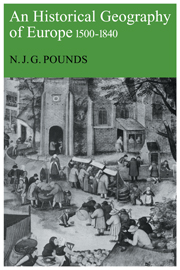Book contents
- Frontmatter
- Contents
- List of maps and diagrams
- List of abbreviations
- Preface
- 1 Europe in the early sixteenth century
- 2 The population of Europe from the sixteenth to the early nineteenth centuries
- 3 The pattern of cities
- 4 Agriculture from the sixteenth to the nineteenth centuries
- 5 Manufacturing and mining
- 6 The pattern of trade
- 7 Europe on the eve of the Industrial Revolution
- Notes
- Index
4 - Agriculture from the sixteenth to the nineteenth centuries
Published online by Cambridge University Press: 04 August 2010
- Frontmatter
- Contents
- List of maps and diagrams
- List of abbreviations
- Preface
- 1 Europe in the early sixteenth century
- 2 The population of Europe from the sixteenth to the early nineteenth centuries
- 3 The pattern of cities
- 4 Agriculture from the sixteenth to the nineteenth centuries
- 5 Manufacturing and mining
- 6 The pattern of trade
- 7 Europe on the eve of the Industrial Revolution
- Notes
- Index
Summary
The sixteenth century was a period of expansion in agriculture, when fresh land was brought under the plough to support a growing population. The following century was marked by stagnation and even contraction, while the eighteenth witnessed renewed growth which continued into the nineteenth. This periodisation is far from precise; it is a rough framework within which to fit the fluctuations in population and in agriculture and production. The growth, contraction and renewed growth in agriculture was in part a response to changes in population, but it can be argued no less that fluctuations in agricultural production were an important factor in demographic change.
The nineteenth-century view that the cause of the trade cycle lay in the weather and cyclical changes in crop yields has long since been discarded as too simplistic. It is, however, less easy to dismiss the weather as a significant factor during the pre-industrial period. People then lived close to the margin of subsistence, and as late as 1820 William Jacob could write of Westphalia that ‘the surplus of the production of the soil in the best years so little exceeds the consumption, that there is no store on hand to meet such years of scarcity as will sometimes occur’. In earlier centuries it could have been said that the yield in the best years barely sufficed for current needs. Famine crises at irregular but not infrequent intervals cut back on the population, and it is not difficult to relate the demographic history of these centuries to the sequence of bad harvests which occurred at intervals during the seventeenth and in the early years of the eighteenth century (see pp. 6–7).
- Type
- Chapter
- Information
- An Historical Geography of Europe, 1500-1840 , pp. 158 - 215Publisher: Cambridge University PressPrint publication year: 1980



